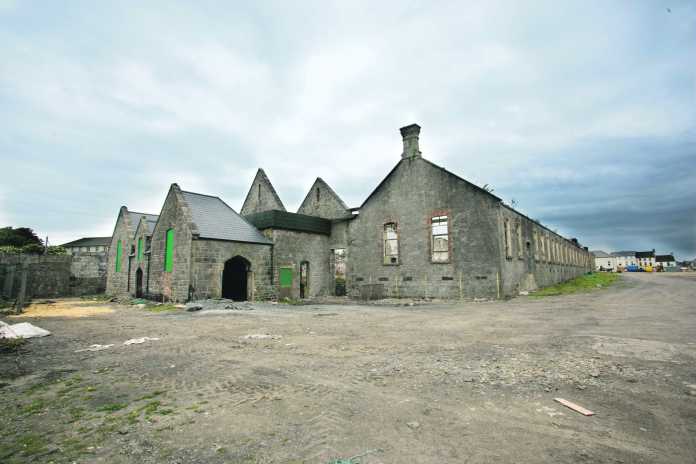
THE Tait Clothing factory employed more than 1,000 workers in Edward Street in its heyday and is now about begin a new chapter in its history. Ahead of an open day at the site this weekend Alan Jacques takes a look at its colourful past and the plans for its future.
The historical site in the heart of the city is now due to start a new chapter with Limerick City and County Council’s plans as part of the Regeneration project to see the former factory premises converted into 83 units of sheltered accommodation.
The façade and shell of the Tait factory has been lovingly preserved and will now be incorporated into the new development on this impressive 3.2-acre site.
If you are interested in social history, industrial archaeology, or just have a curiosity about Limerick’s hidden treasures, then you would be advised to get along to Edward Street this Saturday June 27, where Open House Limerick, in collaboration with the local authority, will give people the opportunity for one last sneak peak around the site before building works commence.
The Limerick Post recently got the opportunity to have a nosey around the Tait site and it’s worth a gander.
While our guide, Limerick City and County Council architect Seamus Hanrahan enthused about the impressive roof trusses in the barracks-like structure, which will form the entrance to the new development, it was the vast scale of the site that took my breath away. It’s massive!
In a short walk around the site you can see the care that has gone into getting the groundwork right, while preserving the noble limestone buildings that are steeped in history. There is huge potential, and the development bodes well for the future of this whole area of the city.
“It would be criminal not to preserve this site,” said Seamus, flinching at the very thought of it being destroyed.
“The site will begin another chapter in its history with a well-considered respectful development of the Tait Clothing Factory as a mixed use scheme including elderly housing, retail, commercial and community uses,” he explained.
“The repurposing of this site will form a part of the wider process of rejuvenation of this part of Limerick City. This open day will provide an opportunity to view the site prior to the main development works commencing.”
Another objective of this weekend’s open day is to collect memorabilia and invite anybody with photographs, letters, stories or objects relating to the Tait Factory to attend.
This information will be photographed and catalogued on the day in the presence of the owner and will form part of an online heritage repository dedicated to the Tait Clothing Factory.
Mr Hanrahan also noted an upcoming additional event, a day-long seminar entitled ‘The Tait Clothing Factory: A Testament to Time’, supported by the Heritage Council, which is planned for Wednesday August 26.

Open House Limerick’s free open day at the Tait Clothing Factory site on Edward Street takes place this Saturday, June 27 from 10am to 3pm. For more information visit www.taitclothingfactory.com.


MAYOR of Limerick for three consecutive terms from 1866 to 1868, Peter Tait was an innovative and flamboyant Scotsman who cast a mighty shadow locally in both industry and politics.
Bizarrely, the Tait Clock was erected in the pioneering entrepreneur’s honour while he was still living, during his second mayoralty. History remembers Tait as a colourful and unusual figure with a love of pomp and splendour.
I can’t imagine the current hoo-ha over Limerick’s two mayors would have sat too well with him. Like all politicians, the renowned clothing manufacturer had a strong egotistical streak, so you can bet your bottom dollar that skin and hair would have flown at the prospect of Tait being relegated to ‘mini-mayor’, aka Metropolitan Mayor.
Second fiddle he did not play!
The son of a Shetland Island shopkeeper, Peter Tait, arrived in Limerick in 1844 at the age of 16. Not a fella to shirk at the prospect of a hard day’s toil either, he began his remarkable rise to the top as a pedlar selling shirts to sailors at Limerick Port and as a counter-hand in a drapery firm in the city centre.
A visionary with big dreams and loftier ambitions, Tait set up his first shirt factory in Bedford Row in 1850. The Henry Ford of his time, the local industrialist was at the peak of his success and power in the 1860s when he was reputed to employ more than 1,000 people at his site on Edward Street.
Did he use child labourers in his workforce?
Well, the history books aren’t too clear, but the age of consent at the time was 12, so make up your own minds on that one!
One thing however, is sure – Tait Clothing Factory was pioneering in the textile industry. The Limerick plant was one of the first in the world using steam power sewing machines rather than hand-stitching; putting ingenious good use to the biblical levels of rainwater we are so accustomed to in these parts.
Not only that, but Tait also pioneered the production line system used globally in industry today, with each worker beavering away making single components rather than the entire product.
This innovation, at one time, placed this facility as the largest and leading clothing manufacturer in the world.
The Tait Clothing Factory was one of the main suppliers to the British Army. Indeed, Peter Tait claimed in 1858 that he had the capacity to supply the entire British Army with clothing, if required. The Limerick factory also played a major role in the American Civil War providing uniforms to the Confederates.
This larger-than-life character did well in Limerick. As well as the worldwide success of his textile empire, the Richard Branson-like tycoon also set up a flax spinning industry locally and a steamship company with ships circumnavigating the globe from London and Antwerp to Buenos Aires and Rio de Janeiro.
None of this though was enough to quell Tait’s ambitions. He held political aspirations with his eye fixed on Parliament and was inevitably drawn into public life. For his three consecutive years as Mayor of Limerick he is said to have filled the role with panache.

Alas, Tait wasn’t totally immune to the old ‘boys with toys’ tomfoolery we’ve come to cringe at on a weekly basis from frivolous local representatives. In the same narcissistic style of today’s brash rap singers and their love of all things ‘bling’, local government’s answer to Kanye West took it upon himself to redesign the mayoral chain at the end of his term in office. Unbeknownst to anyone, he removed two medallions and replaced them with one larger roundel to commemorate his three mayoralties. This did not go down at all well at council and was followed by much stomping and bluster.
Not too much has changed then!
Often compared to Dick Whittington, Peter Tait left the clothing factory in his son’s care before departing Limerick in 1875. He died aged 62 in a seaside city on the Black Sea, leaving behind a paltry estate of £50 after disastrous business ventures.
As they say in Limerick, ‘he was some man for one man’, and one that certainly holds a special place in the hearts and minds of people locally.




